
In cosmetics, product performance, and user experience are paramount to success. In recent years, increasing demand for high-quality cosmetic products has led to a surge in development and innovation. One crucial aspect of cosmetic product application is the brush tip material used in twist pens. So, a suitable brush tip material can help you achieve a perfect finish. However, choosing the wrong one can lead to subpar results.
With the variety of brush tip materials available, selecting the right one can be difficult. But don’t worry; this article will delve into the world of brush tip materials. We’ll explore step by step the pros and cons of different materials and provide best practices for material selection. The ultimate guide to brush tip material is here!
Why Choosing The Right Material Is Important?
By selecting the right brush tip material, brands can ensure their product supports brand success and meet customer expectations. The right material also ensures optimal product performance. Some other reasons are:
- It affects apply makeup, how well the product applies, spreads, and adheres to the skin. It must be gentle and non-irritating to prevent allergic responses and skin reactions.
- The material must be compatible with the product’s formulation to prevent degradation or settling.
- It can differentiate products from competitors, making them stand out.
- A great brush tip material offers an even, smooth, and convenient application experience.
As a result, it enhances user satisfaction.
Factors That Affect the Function Of Cosmetic Twist Pen
The functionality of twist pens, especially lip gloss pens, is intricately tied to various key factors. These include the density and viscosity of the filling liquid, which directly affect the flow and application; the material, shape, and size of the brush tip, which determine precision and user comfort; and the size, design, and surface treatment of the pen body, which enhance both practicality and aesthetic appeal. For cosmetic manufacturers aiming to create standout products, understanding these factors is essential.
By customizing lip gloss pens to align with brand identity and consumer preferences, manufacturers can deliver not only superior functionality but also a memorable user experience. Whether it’s through sleek designs, innovative applicator tips, or eco-friendly materials, tailored lip gloss pens have the potential to elevate brand perception and drive customer loyalty.
1. Brush Tip Material
When we talk about the cosmetic twist pen, its functionality lies in its brush tip. It is the contact point between the product and the consumers’ skin. For that reason, it can make or break the product’s effectiveness. So, the choice of material shapes the user experience and influences the overall quality perception of the product.
Different materials offer pros and cons depending on the desired application method and product formulation. These are:
Brush
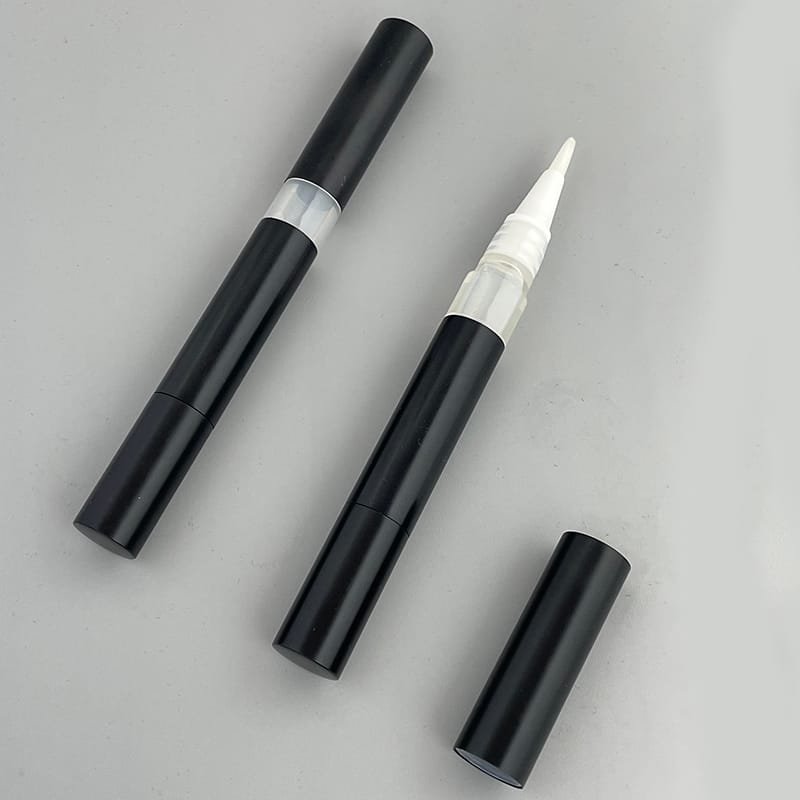
It has the following pros and cons:
Pros:
- Brushes are soft and gentle on the skin, suitable for sensitive areas.
- They offer detailed, fine application and are ideal for eyeliner or eyebrow pens.
- Whether it’s a refreshing toner or a liquid foundation, it’s compatible with Various formulas from liquid to powder.
Cons:
- If used improperly, bristles can lose shape or fray.
- They require regular cleaning to maintain performance and prevent buildup.
Flocking
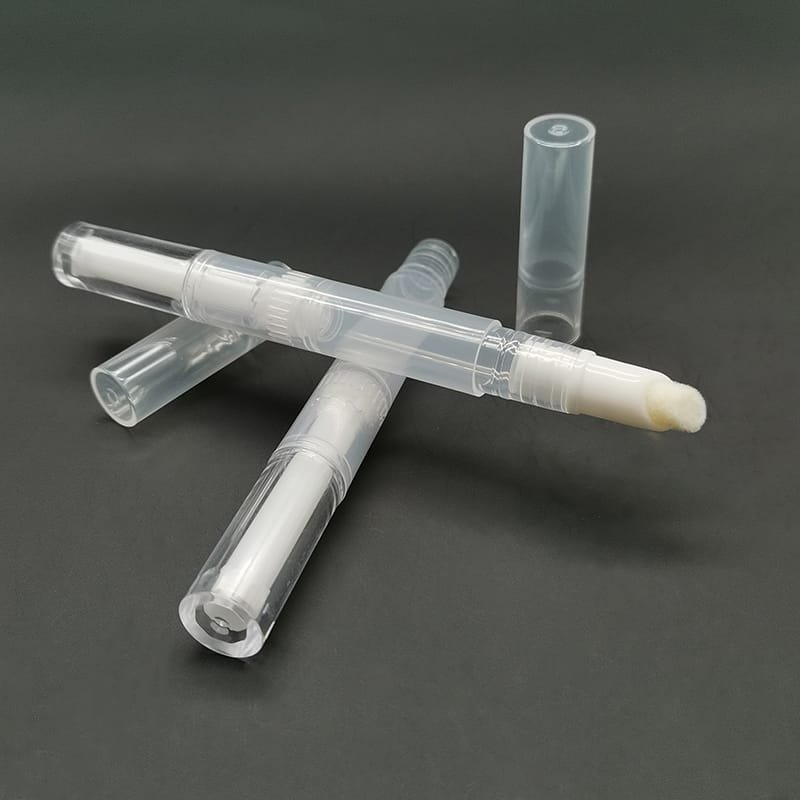
We can not ignore the following pros and cons:
Pros:
- Flocking tips are ideal for those with less experience in makeup application.
- They provide smooth and even application, particularly useful for concealers or lip gloss.
- They help to achieve a consistent finish without clumps or streaks.
Cons:
- These tips may wear out faster.
- They may absorb more product, leading to wastage.
Sponge
The pros and cons of sponge materials are mentioned below:
Pros:
- They are suitable for all skin types, offering gentle application.
- Sponges are excellent for blending. This makes them ideal for highlighter pens or foundations.
- They are ideal for liquid and creams.
Cons:
- Avoid using too much force to avoid damaging the bristles.
- It needs to squeeze out more beauty liquid than ordinary brush tips to apply it evenly.
Silicone
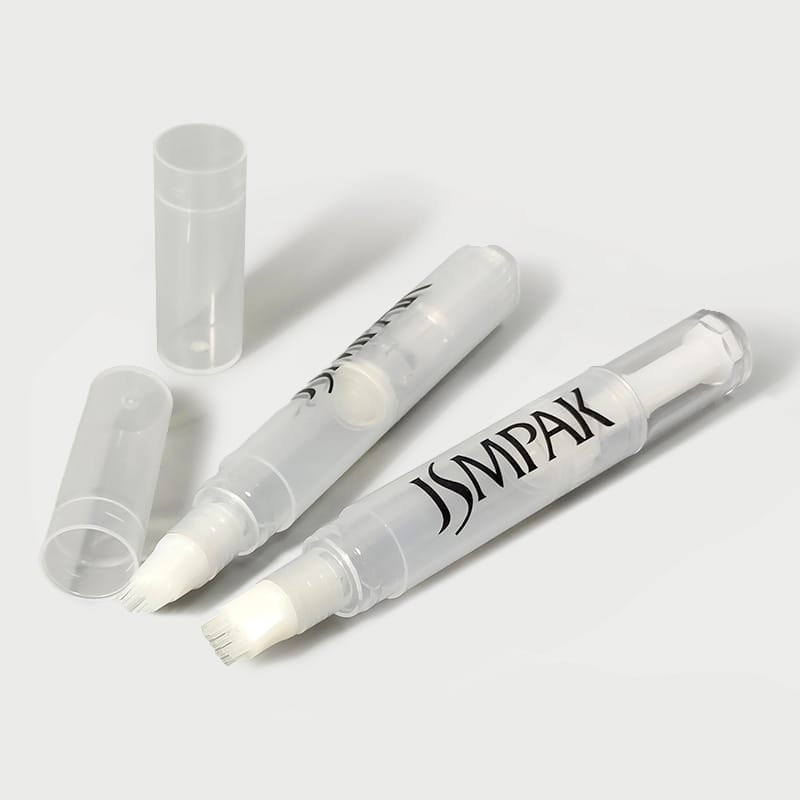
Silicone materials come with pros and cons, as mentioned below:
Pros:
- It is easy to clean.
- Doesn’t absorb the product, ensuring minimal wastage.
- Long-lasting, robust, and resistant to wear and tear.
- Ideal for most cosmetic formulations. However, it may be less effective for powders.
Cons:
- It needs more flexibility for detailed applications.
- It can feel less natural on the skin than brushes or sponges.
Soft Rubber
Soft rubber has the following pros and cons:
Pros:
- Soft rubber tips can maintain their shape over time. They are resistant to damage as well.
- Easy to maintain and clean, reducing the risk of contamination.
- They offer ideal control over product application.
- Equally suitable for liquid and creams. But it may be better for powder formulation.
Cons:
- It may need to provide a smoother application for certain products.
- The texture might not be as comfortable as softer materials.
Plastic
While choosing plastic material, we can not miss out on its pros and cons:
Pros:
- Plastic tips can be molded into various shapes for detailed product application.
- Generally more cost-effective than other materials.
- Highly durable and resistant to damage.
- They are suitable for cream and liquid but must be more effective for powders.
Cons:
- They lack the softness and flexibility.
- They are often harsh on sensitive areas.
2. Shape and Size Affect Cosmetic Pen Performance
The shape and size of the brush tip in a twist pen can strikingly influence its performance and function, especially when it comes to a twist up lip gloss pen. Selecting the right brush tip ensures an even application, enhances the user experience, and complements the product’s overall design. Therefore, it is crucial to carefully evaluate these aspects before making the final selection.
From slim, precise brushes for detailed application to fuller tips for effortless coverage, the diversity in shapes and sizes can meet a wide range of beauty needs. In the following content, we’ll explore the various options available and how they can elevate the functionality of a twist up lip gloss pen.
Let’s dive into the details and discover how the perfect brush design can transform your product.
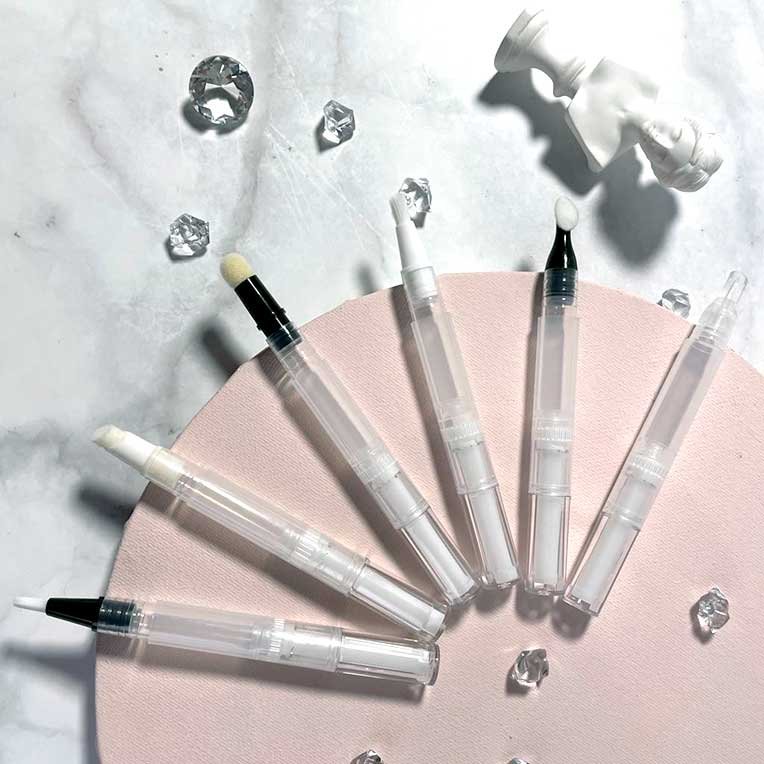
Shapes
Brush tip shape is a make-or-break factor, as it can either hinder or enhance the product’s ability to meet user expectations. That is why it can directly impact the user experience, the product’s performance, and success in the competitive market. Its shapes are:
- Round: Useful for detail work, fine lines, and precise application.
- Pointed: Ideal for creating sharp lines and detail work.
- Flat: Excellent for applying product to large areas and broad strokes.
- Angled: Good for creating sharp lines, precise application, and reaching small areas.
- Filbert: It is a combo of round and flat. It is a great choice for blending and shading.
Sizes
While creating high-quality twist pens, the brush tip acts as a critical variable. It can directly impact the function of the twist pen. The sizes of the twist pen brush are as follows:
- Fine (0.1-0.5mm): Ideal for detail work, precise application, and fine lines.
- Medium (0.5-1.5mm): Good for general-purpose use and creating medium lines.
- Broad (1.5-3 mm): Useful for creating bold lines, broad strokes, and coverage.
3. How to Choose The Appropriate Shape and Size
An ideal brush tip shape and size are critical factors that influence the performance of twist up lip gloss pens. They directly impact product pickup, control, delivery, precision, and overall user experience. So, it is imperative to consider this aspect too. There are a lot of brush tip shapes and sizes available. So choose them wisely according to your needs! Remember the following things while choosing the right brush materials for your products:
- The perfect brush tip size and shape selection allow for a more precise and detailed application.
- They affect the flow of beauty liquid. The larger the tip, the more beauty liquid is needed, and the smaller the tip, the less beauty liquid is needed.
- They can impact accuracy, with pointing tips allowing more precision.
- They can influence expressiveness, with varied tips offering different line effects and widths.
Shape
Brush head shape impacts the product’s control, precision, and overall performance. For that reason, it determines the product’s ease of use, user satisfaction, and effectiveness. That’s why selecting the optimal shape for specific cosmetic applications is essential. Shapes can be:
- Brush: Wide range, suitable for a large number of beauty liquids on the market.
- Cylindrical: It is ideal for general applications such as concealer or lip gloss. It provides smooth and even application over a large area.
- Flat Tip: This applies to contouring creams and foundations. It ensures blending and even distribution over the larger surface area.
- Plastic Flat Tip: It is suitable for precise applications like detailed concealers or lip liners.
Size
Although the physical size of the brush tip is fixed, the contact area between the brush tip and skin can vary. The brush tip size impacts user control and how the product is applied. So, choose the appropriate model size according to the purpose of makeup.
A small contact area allows control and precision, making it ideal for intricate makeup application. It is best for applying eyeliner or spot concealing.
Medium contact area: It balances coverage with precision, making it versatile for multiple uses. It is ideal for general applications like concealer, eyeshadow, or lip gloss.
Large contact area: it ensures efficient and quick application over large areas, reducing application time. Excellent for products that require broad, even coverage like body makeup or foundation.
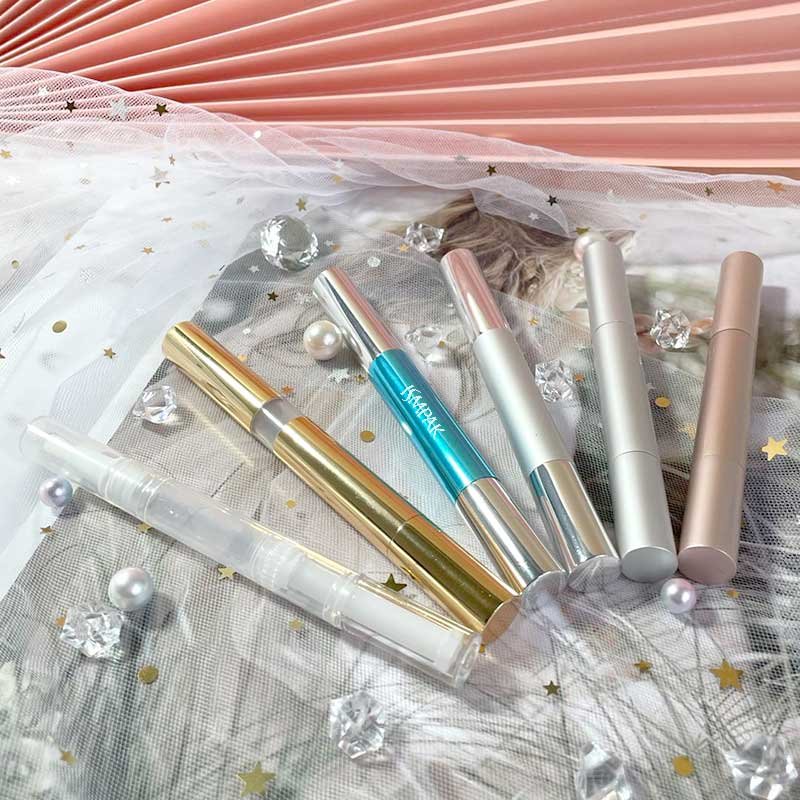
4. The Impact Of Different Materials On Different Cosmetic Formulations
The interaction between brush tip material and cosmetic formulation is key to optimal performance. Different formulations require specific characteristics in a brush tip that will ensure even and smooth application. These include:
Liquid Formulations
Silicone, flocking, and soft rubber are usually preferred for liquid formulations like lip glosses, foundations, and eyeliners. These materials provide a smooth application. Adding more, these are easy to clean, which helps maintain hygiene. Brushes can also be a great choice, especially when precision is needed, as with eyeliners.
Cream Formulations
Cream-based products benefit from the tips that can blend the product easily into the skin. Brush and sponge tips are perfect for liquid formulations like concealers and cream blushes. Silicone tips can also be used, particularly for their ease of cleaning.
Gel Formulations
Gel formulations are usually found in eyebrows or eyeliner products. They require tips that can provide control and precision. Soft rubber tips and brush tips are excellent choices, offering accuracy and detail.
5. Choosing The Right Brush Tip For Your Needs
When selecting brush tip material for your twist pen, consider the following best practices:
- First, determine the specific application and desired finish. This will lead you to select the right material, shape, and size.
- Examine the pros and cons of each material. Consider factors such as product compatibility and durability.
- Pay attention to whether the raw materials used by suppliers have an impact on beauty products, including environmental impact.
- Follow market trends and attend industry events to stay updated with the latest advancements in the cosmetic industry.
- Keep in mind the preferences and skin types of your customers. Do they require precise, firm ones or flexible, gentle brush tips?
- Test multiple brush tips and gather and analyze feedback to refine your selection.
- Collaborate closely with your brush tip suppliers to customize materials that meet your needs. At Jasmine Packaging, we offer you the best brush tip materials for your brand!
Final Thoughts
To wrap up, the brush tip material, shape, and size, along with the brush tip shape and size, can significantly impact the functionality of twist pens. Manufacturers can create high-quality products by understanding each material’s pros and cons and suitability for specific formulations. These products will not only meet but exceed your customer’s expectations. Make an informed choice, choose the right material for your twist up lip gloss pen, and unlock your full potential. This will leave your customers delighted and loyal.
Explore the full potential of your cosmetic twist pen with the ideal brush tip material and size. Contact Jasmine Packaging for high-quality twist pen brush materials to make your brand stand out!



